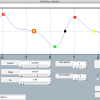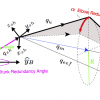Inspired by those findings a model based on dynamical systems was proposed both, to model goal directed trajectories in humans and to generate trajectories for redundant anthropomorphic robotic arms. The analysis of the attractor dynamics based on the qualitative comparison with measurements of resulting trajectories taken from arm movement experiments with humans (Grimme u. a., 2012) created a framework able to reproduce and to generate naturalistic human like arm trajectories (Iossifidis und Rano, 2013; Iossifidis, Schöner u. a., 2006).
Author: jannis
Eingeladener Vortrag beim MINT TAG 2015: https://kt-essen.lms.schulon.org/mod/resource/view.php?id=1496 Was ist Denken? Wie entsteht es? Und warum kann der Mensch es so gut und Maschinen – trotz Computerisierung – nicht? Die neuronalen Strukturen bilden die Basis des Denkens beim Menschen. Jedoch erst die Einheit von Geist und Körper, die Fähigkeit zu komplexen Bewegungen und die stete Interaktion … Read More “MINT TAG 2015: From Brain To Machine and Back” »
Eingeladener Vortrag beim MINT TAG 2015:
https://kt-essen.lms.schulon.org/mod/resource/view.php?id=1496
Was ist Denken? Wie entsteht es? Und warum kann der Mensch es so gut und Maschinen – trotz Computerisierung – nicht?
Die neuronalen Strukturen bilden die Basis des Denkens beim Menschen. Jedoch erst die Einheit von Geist und Körper, die Fähigkeit zu komplexen Bewegungen und die stete Interaktion mit der Umwelt erzeugt kognitive Funktionen. Anhand zahlreicher Beispiele illustriert dieser interessante Vortrag die Zusammenhänge zwischen neuronalen Strukturen, Denken und Kognition vor dem Hintergrund der Evolution bei Mensch und Maschine.
The DynSys-Simulator implement a numerical solution for dynamical systems used in the attractor dynamics approach to robotics. Position, range and number of attractors and repellors can be changed interactively while the phase plot is updated in an closed loop. The simulator visualizes the behavior of the dynamical systems and can give an intuition how it … Read More “Dynamical System Simulator” »
In the current work a closed form solution for a multi redundant open chain manipulator is presented. Exploiting the geometrical properties of the open chain we derive first ananalytic solution for the seven degree of freedom arm. And introduce then a methodology to incorporate additional degree of freedoms in the chain preserving the closed form … Read More “ICRA2013:Closed Form Solution for Inverse Kinematical Mapping for Redundant Open Chain Manipulators (submitted)” »
In the current work a closed form solution for a multi redundant open chain manipulator is presented. Exploiting the geometrical properties of the open chain we derive first an analytic solution for the seven degree of freedom arm. And introduce then a methodology to incorporate additional degree of freedoms in the chain preserving the closed … Read More “ICRA2013:Closed Form Solution for Inverse Kinematical Mapping for Redundant Open Chain Manipulators(submitted)” »
Movement generation in robotics is a well know problem with many excellentsolutions. Most of them, however, look for optimal solutions according to some metrics, but have no biological inspiration. From a human perspective these techniques behave in a non-naturalistic way. This poses a problem for human-robot interaction and, in general, for a good acceptance of robots … Read More “Robio2013(submitted):Modeling Human Arm Motion by Means of Attractor Dynamics Approach” »
Movement generation in robotics is a well know problem with many excellent solutions. Most of them, however, look for optimal solutions according to some metrics, but have no biological inspiration. From a human perspective these techniques behave in a non-naturalistic way. This poses a problem for human-robot interaction and, in general, for a good acceptance … Read More “Robio2013:Modeling Human Arm Motion by Means of Attractor Dynamics Approach” »
Baxter press his kill switch
Treffen Sie uns auf der ITSC2012 in Alaska. Wir präsentieren unsere Arbeit zur Entwicklung einer integrierten Architektur zur Entwicklung und Prüfung von Fahrerassistenzsystemen. Abastract: Advanced Driver Assistant Systems act, by definition in natural, often poorly structured, environments and are supposed to closely interact with human operators. Both, natural environments as well as human behaviour have no … Read More “ITSC2012: An Integrated Architecture for the Development and Assessment of ADAS” »

 Over the last decades the generation mechanism and the representation of goal- directed movements has been a topic of intensive neurophysiological research. The investigation in the motor, premotor, and parietal areas led to the discovery that the direction of hand’s movement in space was encoded by populations of neurons in these areas together with many other movement parameters. These distributions of population activation reflect how movements are prepared ahead of movement initiation, as revealed by activity induced by cues that precede the imperative signal (Georgopoulos, 1991).
Over the last decades the generation mechanism and the representation of goal- directed movements has been a topic of intensive neurophysiological research. The investigation in the motor, premotor, and parietal areas led to the discovery that the direction of hand’s movement in space was encoded by populations of neurons in these areas together with many other movement parameters. These distributions of population activation reflect how movements are prepared ahead of movement initiation, as revealed by activity induced by cues that precede the imperative signal (Georgopoulos, 1991).

